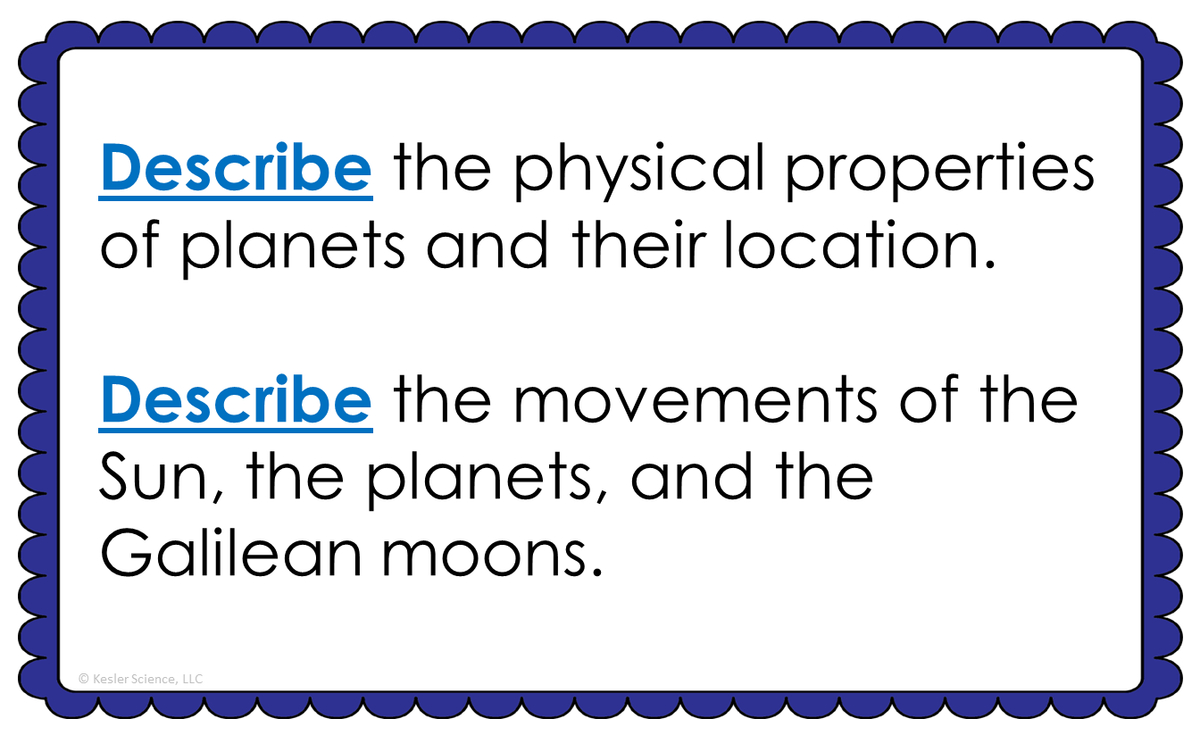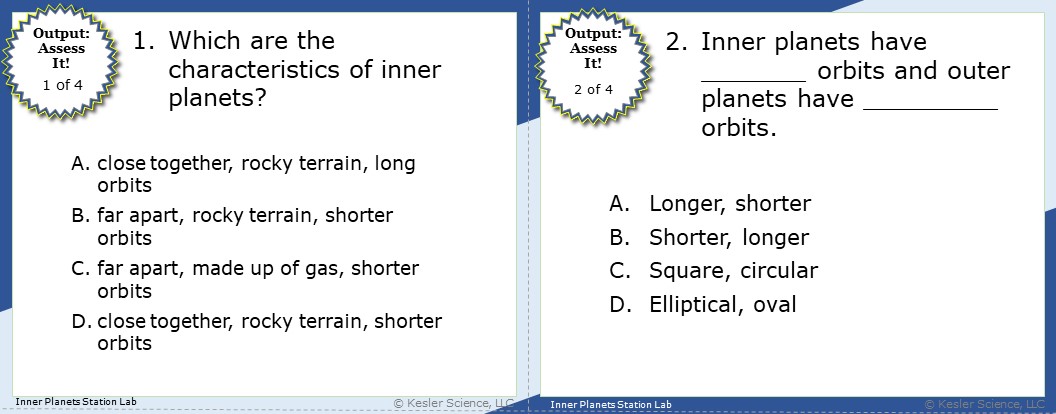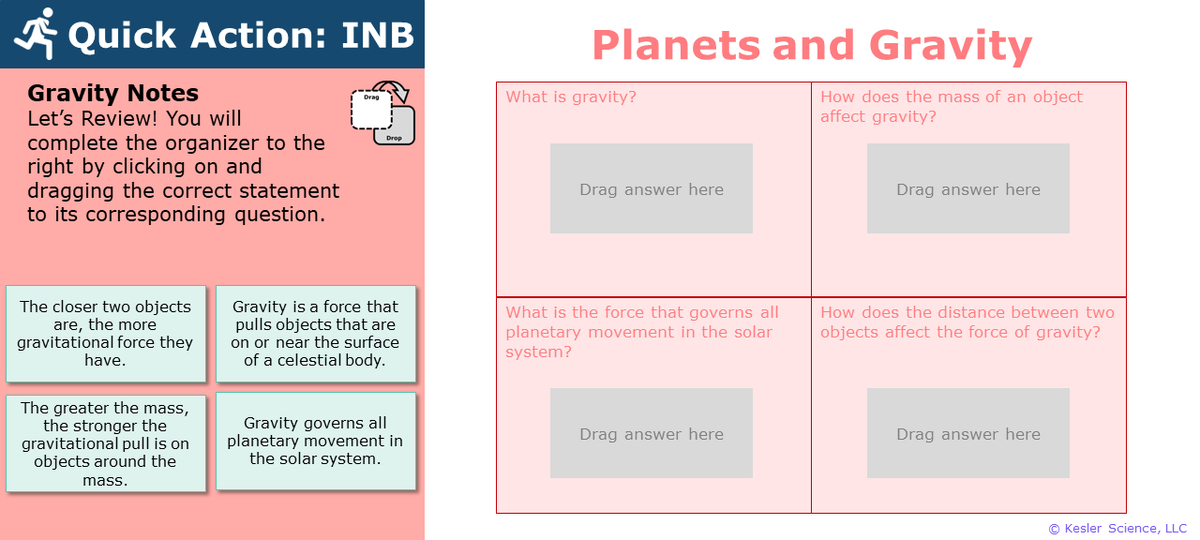Planets Lesson Plan – A Complete Science Lesson Using the 5E Method of Instruction
At the end of this comprehensive planets lesson plan, students will be able to describe the physical properties of the planets and their locations. They will also be able to describe the movements of the Sun, the planets, and the Galilean moons. Each lesson is designed using the 5E method of instruction to ensure maximum comprehension by the students.
The following post will walk you through each of the steps and activities from the planets lesson plan.
ENGAGEMENT
At the beginning of the lesson, the class will discuss the objectives and some of the relevant vocabulary using the included objective statements and word wall cards.

The engagement activity continues with a with a Think-Pair-Share activity. Students will brain-storm words that relate to planets from A to Z. Students will then be asked to share out ideas to the rest of the class. This activity will allow teachers to see where student misconceptions are on the topic of planets like whether or not we have visited other planets.
Estimated Class Time for the Engagement: 20-30 minutes
EXPLORATION
There are two student-centered station labs setup so students can begin to explore the differences between the inner and outer planets. In the 5E lesson plan, there is even a bonus lab and activity that teaches students about gravity as well. There are eight stations in each lab. Four of the stations are considered input stations where students are learning new information about the planets, and four of the stations are output stations where students will be demonstrating their mastery of the input stations. Each of the stations is differentiated to challenge students using a different learning style. You can read more about how I setup the station labs here.
EXPLORE IT!
Inner Planets-
Students will be building a scaled model of the solar system. This station is setup to get students to explore the distances of the inner planets compared to that of the outer planets. Students will then have to answer a couple questions regarding space travel and planetary orbit.
Outer Planets-
Students will be placing ping-pong balls in cups that relate to either inner planets, outer planets, or both groups. Each ping-pong ball will have information pertaining to inner, outer, or both groups of planets written on them.
WATCH IT!
Inner Planets-
At this station, students will be watching a six minute video learning about the order, distance, and composition of the inner planets. There are 4 questions relating to each of the inner planets which students will need to answer on their lab sheet.
Outer Planets-
At this station, students will also be watching a six minute video learning about the order, distance, and composition of the outer planets. There are 4 questions relating to each of the outer planets which students will need to answer on their lab sheet.
RESEARCH IT!
Inner Planets-
The research station will allow students to get online and cycle through a slide show. Students will be encouraged to write down any new information that did not know before about the inner planets on their lab sheet.
Outer Planets-
The research station will allow students to get online and cycle through a slideshow. Students will be encouraged to write down any new information that did not know before about the inner planets on their lab sheet.
READ IT!
Inner Planets-
This station will provide students with a one page reading about the four terrestrial planets. Students are asked four questions about the reading and will begin to understand how the planets were formed and each planets individual composition.
Outer Planets-
Students are asked four questions about the reading and will begin to understand which planets make up the outer planet grouping, Jovian planets, and a possible alternate title based on their understanding of the passage.
ASSESS IT!
Inner Planets-
The assess it station is where students will go to prove mastery over the concepts they learned in the lab. The questions are setup in a standardized format with multiple choice answers. Some questions will ask students about characteristics of planets and some will ask students about planetary orbits.

Outer Planets-
In this station, students will be asked questions about an outer planet’s characteristics, orbits, and gravity strength.
WRITE IT!
Inner Planets-
Students who can answer open-ended questions about the lab truly understand the concepts that are being taught. At this station, the students will be answering three questions comparing distances between the inner and outer planets, characteristics of the inner planets, and why travel to Venus would be unlikely.
Outer Planets-
This station students will have to describe one of the outer planets, how scientist learn about outer planets, and compare and contrast Jupiter and Saturn.
ILLUSTRATE IT!
Inner Planets-
Your visual students will love this station. Students will be drawing a Venn diagram categorizing the differences and similarities of the inner and outer planets.

Outer Planets-
Students will draw how different outer planets are from inner planets.
ORGANIZE IT!
Inner Planets-
The organize it station allows your students to use a manipulative to ensure their understanding each of the inner planets and their characteristics.
Outer Planets-
The organize it station allows your students to use a manipulative to ensure their understanding each of the outer planets and their characteristics.
Estimated Class Time for the Exploration: 1-2, 45 minute class periods
EXPLANATION
The explanation activities will become much more engaging for the class once they have completed the exploration station lab. During the explanation piece, the teacher will be clearing up any misconceptions about the planets and gravity with an interactive PowerPoint, anchor charts, and interactive notebook activities.
The planets lesson includes a PowerPoint with activities scattered throughout to keep the students engaged.
The students will also be interacting with their journals using INB templates for planets. Each INB activity is designed to help students compartmentalize information for a greater understanding of the concept. The planets INB templates will challenge the students to understand the characteristics of inner and outer planets. The gravity INB template will help students to understand how the force of gravity is affected by the size of objects and distances between objects.
Estimated Class Time for the Exploration: 2-3, 45 minute class periods
ELABORATION
The elaboration section of the 5E method of instruction is intended to give students choice on how they can prove mastery of the concept. When students are given choice the ‘buy-in’ is much greater than when the teacher tells them the project they will have to create. Each of the planet projects will allow students to explain distances, formations, and characteristics of each of the planets in the solar system.

Estimated Class Time for the Elaboration: 2-3, 45 minute class periods (can also be used as an at-home project)
EVALUATION
The final piece of the 5E model is to evaluate student comprehension. Included in every 5E lesson is a homework assignment, assessment, and modified assessment. Research has shown that homework needs to be meaningful and applicable to real-world activities in order to be effective. When possible, I like to give open-ended assessments to truly gauge the student’s comprehension.
Estimated Class Time for the Elaboration: 1, 45 minute class period
DOWNLOAD THE FULL LESSON NOW
The full lesson is available for download from the Kesler Science Store. Save yourself a ton of time and grab it now.

Download Over $100 in FREE Resources
For Middle School Science
Simply create a login below and gain immediate access to a selection of our Kesler Science product line worth $100 - for FREE. There's a full version of every product type! You'll also join tens of thousands of middle school science teachers who receive timely tips and strategies straight to their inbox.




